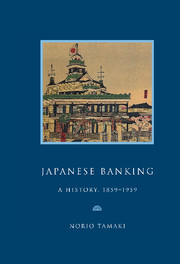Book contents
- Frontmatter
- Contents
- Preface
- Genealogy of leading Japanese banks, 1859–1959
- List of abbreviations
- Map
- Part I A bankrupt Shogunate, 1859–1868
- Part II The Meiji Restoration: monetary confusion and banking experiments, 1868–1881
- Part III Matsukata, the wizard of Japanese banking, 1881–1897; the Yokohama Specie Bank (1880) and the Bank of Japan (1882)
- Part IV The Japanese on the London money market, 1897–1911
- Historical background
- 13 The ‘Siamese twins’: Nichigin and Shokin, 1897–1911
- 14 Special banking, 1897–1911
- 15 Banking at the end of the Meiji era, 1900–1911
- 16 Banking and the securities market, 1897–1911
- Part V War, the Japanese boom years, 1911–1919
- Part VI Crisis and the road to war, 1919–1937
- Part VII Complete commitment, struggle and defeat, 1937–1945
- Part VIII American ‘democratisation’ and the search for growth, 1945–1959
- An extraordinary century, 1859–1959
- Appendices
- Notes
- Bibliography
- Index
15 - Banking at the end of the Meiji era, 1900–1911
Published online by Cambridge University Press: 03 February 2010
- Frontmatter
- Contents
- Preface
- Genealogy of leading Japanese banks, 1859–1959
- List of abbreviations
- Map
- Part I A bankrupt Shogunate, 1859–1868
- Part II The Meiji Restoration: monetary confusion and banking experiments, 1868–1881
- Part III Matsukata, the wizard of Japanese banking, 1881–1897; the Yokohama Specie Bank (1880) and the Bank of Japan (1882)
- Part IV The Japanese on the London money market, 1897–1911
- Historical background
- 13 The ‘Siamese twins’: Nichigin and Shokin, 1897–1911
- 14 Special banking, 1897–1911
- 15 Banking at the end of the Meiji era, 1900–1911
- 16 Banking and the securities market, 1897–1911
- Part V War, the Japanese boom years, 1911–1919
- Part VI Crisis and the road to war, 1919–1937
- Part VII Complete commitment, struggle and defeat, 1937–1945
- Part VIII American ‘democratisation’ and the search for growth, 1945–1959
- An extraordinary century, 1859–1959
- Appendices
- Notes
- Bibliography
- Index
Summary
Five big fish and a mass of minnows: the banks, 1900–1911
In 1901 there were 1,867 ordinary banks in Japan, but a decade later this number had dropped to 1,613. In Britain in 1911 there were about 100 banks following various bank amalgamations. During these years in Japan ordinary banking increased its advances twofold and deposits nearly threefold. Savings banks also increased in number from 419 to 478 while their advances and deposits increased more than three and four times respectively. Advances as percentages of deposits of both ordinary and savings banking showed the same trend. The former declined from 151 per cent to 100 per cent standing at 120 per cent on average, while the latter did so from 80 per cent to 60 per cent, standing at 70 per cent on average. The trend was certainly due more to augmentation of their deposits rather than to their unwillingness to lend, as the above figures indicated.
The regulations in the legislation during the 1890s for ordinary and savings banking were similar. It could safely be said that the only difference between the two banking categories was a matter of scale. Therefore, it may be wise to start discussions from comparisons of three figures of average capital, advances and deposits in order to clarify their positions. In terms of average capital, savings banking grew from 28 per cent of that of its ordinary counterpart in 1900 to 49 per cent in 1911.
- Type
- Chapter
- Information
- Japanese BankingA History, 1859–1959, pp. 104 - 107Publisher: Cambridge University PressPrint publication year: 1995



